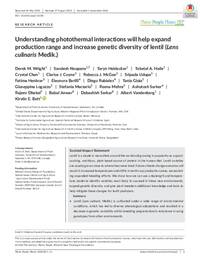Understanding photothermal interactions will help expand production range and increase genetic diversity of lentil (Lens culinaris Medik.)
Published Date
October 15, 2020
Type
Journal Article

Authors:
Sandesh Neupane, Sandesh Neupane, Taryn Heidecker, Teketel A. Haile, Crystal Chan, Clarice J Coyne, Rebecca McGee, Sripada M. Udupa, Fatima Henkrar, Eleonora Barilli, Diego Rubiales Olmedo, Tania Gioia, Giuseppina Logozzo, Stefania Marzario, Reena Mehra, Ashutosh Sarker, Rajeev Dhakal, Babul Anwar, Debashish Sarkar, Albert Vandenberg, Kiristin Bett
Lentil is a staple in many diets around the world and growing in popularity as a quick‐cooking, nutritious, plant‐based source of protein in the human diet. Lentil varieties are usually grown close to where they were bred. Future climate change scenarios will result in increased temperatures and shifts in lentil crop production areas, necessitating expanded breeding efforts. We show how we can use a daylength and temperature model to identify varieties most likely to succeed in these new environments, expand genetic diversity, and give plant breeders additional knowledge and tools to help mitigate these changes for lentil producers.
Citation:
Derek M. Wright, Sandesh Neupane, Taryn Heidecker, Teketel A. Haile, Crystal Chan, Clarice J Coyne, Rebecca McGee, Sripada M. Udupa, Fatima Henkrar, Eleonora Barilli, Diego Olmedo, Tania Gioia, Giuseppina Logozzo, Stefania Marzario, Reena Mehra, Ashutosh Sarker, Rajeev Dhakal, Babul Anwar, Debashish Sarkar, Albert Vandenberg, Kiristin Bett. (15/10/2020). Understanding photothermal interactions will help expand production range and increase genetic diversity of lentil (Lens culinaris Medik. ). Plants, People, Planet.
Keywords:
diversity
adaptation
climate change
phenology
temperature
photoperiod
lentils
